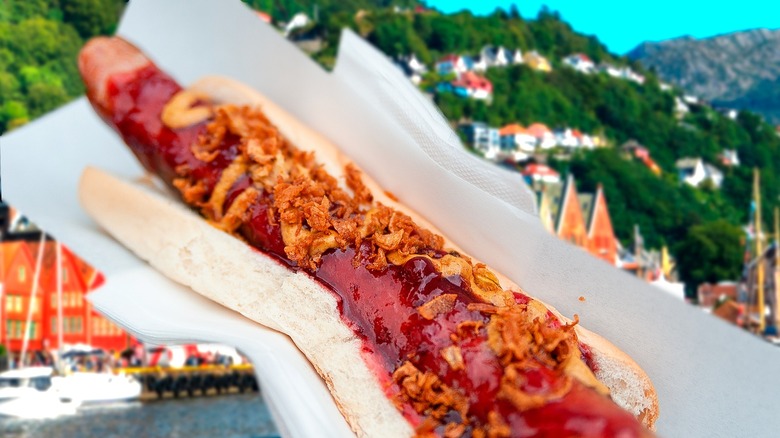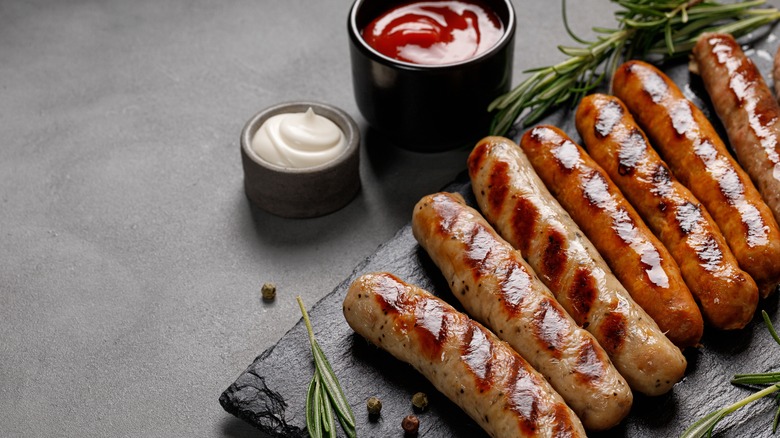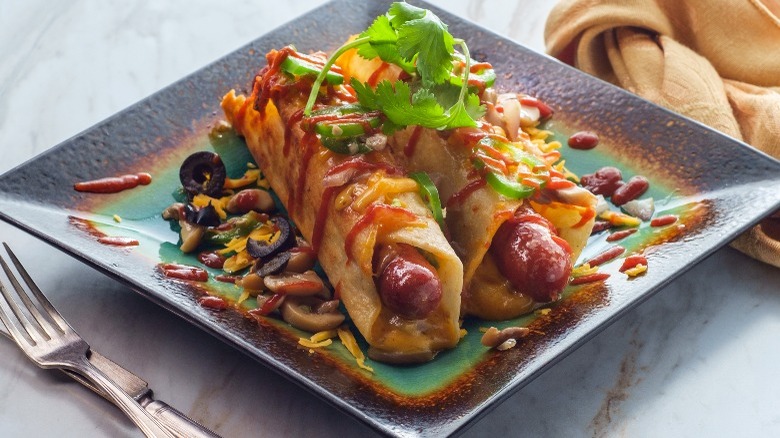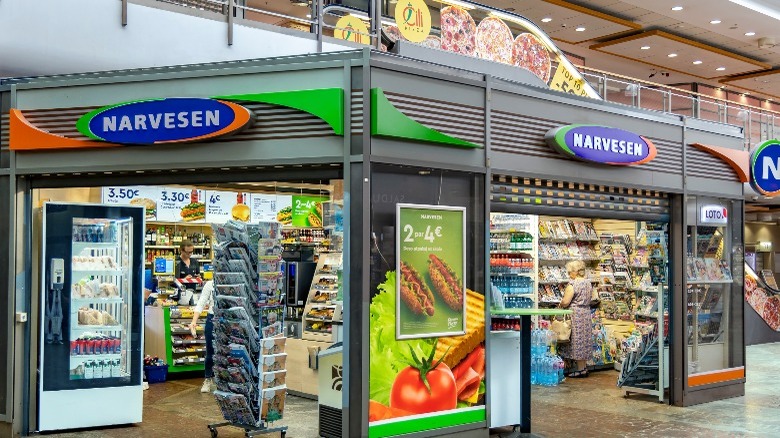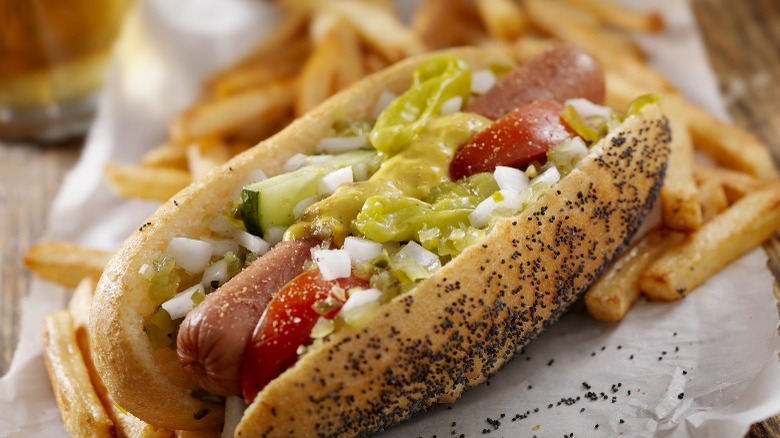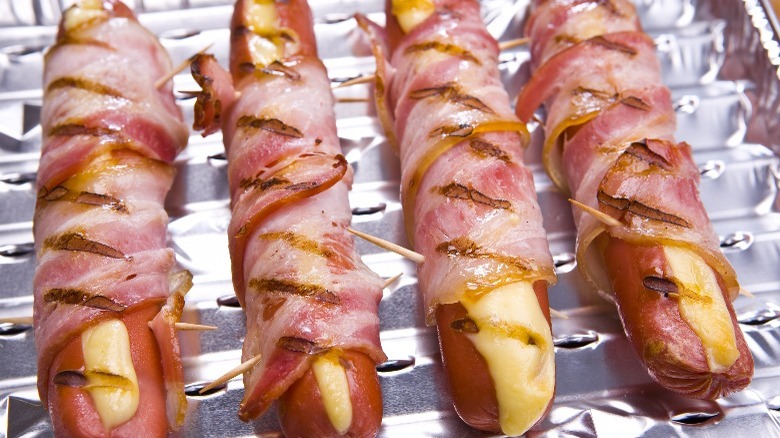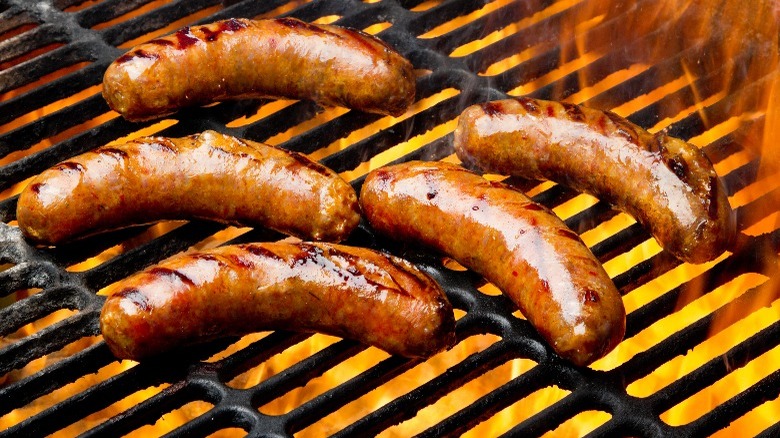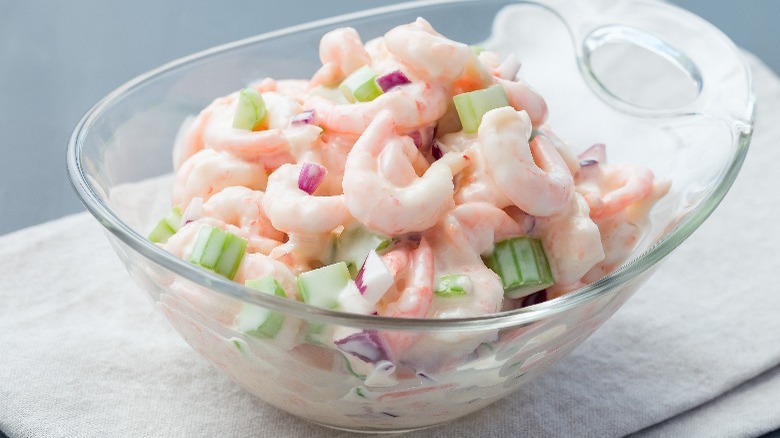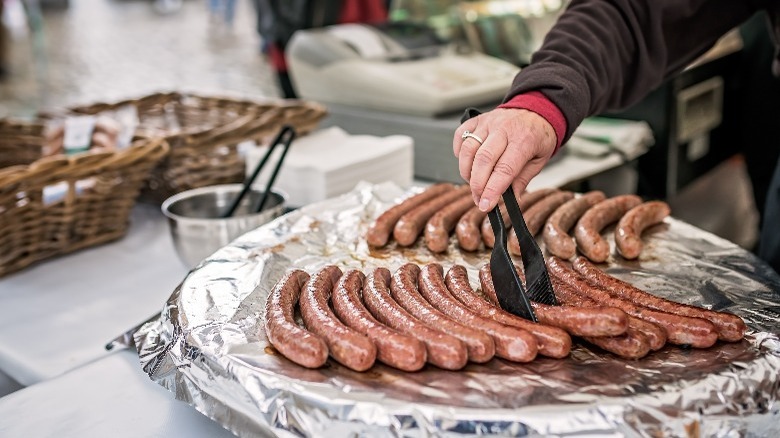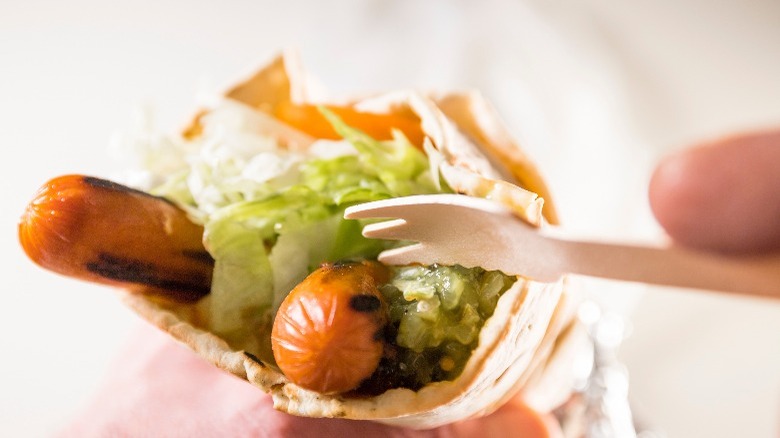How Norway Came To Fall In Love With The Humble Hot Dog
If you think of Norway, towering mountains, icy fjords, the Northern Lights, and ancient Viking myths and legends might all come to mind. It is probably fair to say that hot dogs may not be the first thing people associate with this Scandinavian country. However, Norwegians are almost as obsessed with their hot dogs as we are here in the U.S. In fact, the residents of Norway love hot dogs so much that they have become the country's national snack.
But how did this happen? Why do Norwegians love hot dogs so much, and what variations on the classic hot dog can you find in the country's different regions? We dive into Norway's ever-evolving relationship with this humble snack and look at how the sausage dish rose to popularity, the demise of the hot dog stall, and what toppings Norwegians enjoy — plus why gas station hot dogs are a serious endeavor in Norway.
Norwegians have always loved sausages
The sausage isn't new to Norway. Way back in Viking times, kjeleormer, or kettle worms, were enjoyed at feasts, so-called "for how they coiled in the pot," according to Atlas Obscura. These later evolved into the country's Christmas sausage, made from medister dough, a blend of minced pork and warming spices. The prepared sausages are usually hung to dry for two to three days.
The hot dog as we know it today didn't arrive in Norway until much later. In the 1950s, following World War II, U.S. fast food hit Scandinavia. Norway's answer to the U.S. hot dog, Pølse med brød, or sausage with bread, came to the country and was an instant hit amongst young people in particular.
Since then, the hot dog has been through many iterations, changing with the times to keep up with tastes and expectations. Where hot dogs were once made from pork meat, today, you'll find chicken, reindeer, and plant-based dogs, among several others.
Norwegianizing foreign dishes
Even as the hot dog became a culinary craze across the country, dishes from other countries also began to be Norwegianized. One good example is pølse i lompe. This tortilla-style soft bread made with potato flour, similar to what Norwegian-Americans call lefsa, is rolled around the sausage and has fast become the most popular way to serve hot dogs across Norway. Today, six out of 10 Norwegians tuck into a hot dog at least once a month, with 450 million eaten yearly. That's around 100 hot dogs per person.
Of course, like most countries, Norwegians have added their own spin on many dishes, from subbing reindeer meat for beef in traditional stews to making a lighter, sharper potato salad than we're used to in the U.S. with sour cream, lemon, and dill. You'll find many creamy Norwegian salads use more crème fraîche or sour cream than mayonnaise, especially refreshing during the summer months.
Norway takes its hot dogs seriously
One thing you'll notice about hot dogs in Norway is that they're generally delicious and high quality, no matter where you buy them from. That's because Norwegians take the art of hot dog making seriously.
Back in the 1980s, Arne Vidar, son of Leiv Vidar, founder of the Leiv Vidar sausage brand, became the first person to take gas station hot dogs seriously. To this day, Leiv Vidar sends staff at gas stations to sausage school to help them learn about how to serve the best hot dogs at the perfect temperature so they taste amazing.
Leiv Vidar isn't alone, though. At Narvesen, Norway's biggest convenience store chain, staff also get hot dog training, as do team members at 7-Eleven Norway. That makes sense considering that the store's biggest food offering is the classic hot dog, though stores serve up a range of less-classic options too, nowadays, from ostrich and crocodile-meat hot dogs to plant-based dogs.
The hot dog becomes Norway's national snack
But just how did the humble hot dog make its way into the stomachs and hearts of Norwegians? At an early age, Norwegians are taught to gather around an open fire to grill sausages, which typically becomes a yearly family camping tradition. Making sausages are also an integral part of celebrating birthday parties.
But hot dogs are not just for children — people of all ages enjoy and partake in eating this simple food. In fact, on May 17, Syttende Mai — also known as Nasjonaldagen (National Day) or Grunnlovsdagen (Constitution Day) — Norwegians come together in national dress to celebrate the 1814 signing of the constitution.
It's a holiday that's taken very seriously, with street parties, parades, live music, and BBQs — and hot dogs are a key part of the celebration. You'll find hot dog vendors on almost every street corner as well as families throwing their own celebrations, serving up Norwegian-style hot dogs alongside ice cream. According to Atlas Obscura, "On May 17, [2023], Norway's national day, the country's 5.4 million people celebrated by eating an estimated 13 million hot dogs."
High demand equals high-quality dogs
Gas station hot dogs aren't exactly healthy eating, despite the care and dedication spent training staff on how to serve up the best dogs. However, as Norwegians have become more health-conscious in recent years, the quality of hot dogs in the country has risen. These days, even hot dogs sold in Norwegian gas stations typically contain a minimum of 50% meat and no more than 20% fat.
As tastes and dietary requirements change, we've also seen several other options come to the market. Nowadays, you'll find everything from gluten-free and halal hotdogs to plant-based dogs, usually made from vegetable or soy protein. Chicken dogs have also become a bit hit in recent years — this offers a lighter alternative for those who do not eat pork or beef. The best part about these healthier options? Feel free to load up on toppings a little more than usual.
Regional variations on the classic hot dog
You're not limited to just one type of hot dog in Norway, as each region has its own variations. So, depending on where you visit, you can enjoy a different sausage style. In Western and Central Norway, the grill sausage is the most popular. This is a smooth, American-style hot dog served in a traditional white bun or lompe.
Head for the Oslo area, and you're more likely to enjoy Wiener sausage, with its casing making a "knekk" or snap when you bite into it. Nationwide you'll also find typically Norwegian specialties like reindeer hot dogs.
As well as regional variations on the hot dogs themselves, many stalls and eateries experiment with imaginative toppings. Of course, you can keep things traditional with ketchup and mustard, but Norwegians typically enjoy a wide range of different toppings, from fried or raw onions to prawn salad, potato salad — even mashed potatoes.
Hot dogs, Norwegian style
Norway has two main types of hot dogs to try: Wienerpølse and Grillpølse. Wienerpølse are curved hot dogs generally made with pork — though sometimes you'll find chicken versions, too, known as Kyllingpølse. This type of hot dog is usually made from plain meat without any spices or strong flavorings, so it's a popular choice for serving to kids. Wienerpølse are steamed in hot water, which makes them easy and quick to prepare.
In contrast, Grillpølse are a more popular choice for adults due to their chunkier size and texture and stronger, smokier flavor from grilling. These sausages are straight rather than curved. In contrast to the plain Wienerpølse, you'll find a variety of different flavors of Grillpølse, including baconpølse, sausage wrapped in bacon, and ostepølse, which comes filled with cheese.
Other popular ingredients added to Grillpølse include spicy additions such as chili, chorizo, or jalapeño. Grillpølse are usually cooked on an outside grill or indoors using a frying pan and have a more intense flavor than Wienerpølse.
In Norway, you can choose from two types of buns: A traditional hot dog bun or a lompe, a potato tortilla wrapped around your hot dog. When you add toppings, a lompe can be much messier to eat, especially if you're on the go.
The hot dog to top all others
Potato salad is a popular hot dog topping in Norway. It's a sharper version of the potato salad we enjoy in the U.S., typically made with less mayo and more sour cream, and the addition of dill pickles, dill, mustard, lemon juice, and often pickle juice. If that sounds like something you wouldn't like on top of a classic hot dog, why not try rekesalat?
Rekesalat, or shrimp salad, is one of the most popular ways to top a hot dog in Norway. Bursting with creamy flavor, fresh shrimp are dressed in sour cream or crème fraîche, with diced hardboiled eggs, mayo, lemon juice, and fresh dill.
Then there are the more classic toppings like fried or raw onions — other toppings like pickles or mashed potatoes aren't unheard of either. Norwegians will normally choose a couple of the above toppings, which can either be piled on top of your hot dog or sandwiched between the bun or lompe and the dog. The choice is yours.
The demise of the hot dog stall
Norway was once packed with street hot dog stall kiosks and vendors. However, these have gradually disappeared from city streets over the past 30 years. Today, people tend to head to their nearest 7-Eleven, gas station, convenience store, or supermarket to grab a hot dog.
At one point, there were over 40 hot dog stands across the city of Oslo, but today, only one remains. Syverkiosken is Oslo's last remaining hot dog stand, serving up fresh, delicious hot dogs to hungry patrons since 1979. Today the brightly colored retro kiosk has become an Oslo landmark, with its hot dogs remaining one of the most affordable snacks in the city.
Owner Erlend Dahlbo credits the success of his kiosk to its late opening, family recipes, and boiled wiener (Viennese) sausage. Hot dogs are served with a thick potato pancake topping and are regularly topped with local ingredients. If you're lucky enough to find yourself here, order the Special, a hot dog served in a bread roll topped with potato salad and freshly foraged local forest mushrooms.
Scandinavia's most popular hot dogs
As well as the traditional American-style pølse, several other types of hot dogs are extremely popular across other Nordic countries like Denmark, Finland, Iceland, and Sweden. Norwegians love reindeer hot dogs, which are especially popular in Bergen at Trekroneren market. There, reindeer sausages from the north are served in a bun with lingonberry sauce, fried onions, and mustard.
In Denmark, pølser, often called rød pølser, has been around since the early 1920s and consists of a red-colored sausage made with 100% pork. It's typically served in a bun and traditionally enjoyed with a cold beer.
If you ever find yourself in Sweden, consider trying a Halv Special — a hot dog covered with mashed potatoes. This is usually served with ketchup, pickles, mustard, and fried onions — the sausages can be boiled or grilled. Swedes like to enjoy chocolate milk with their Halv Special.
Finally, another Swedish item to try is the Tunnbrödsrulle. This popular street food is made with boiled or grilled sausages and is then wrapped in flatbread. You can choose from a range of toppings, including shrimp salad, mashed potatoes, lettuce, onions, ketchup, and mustard.
